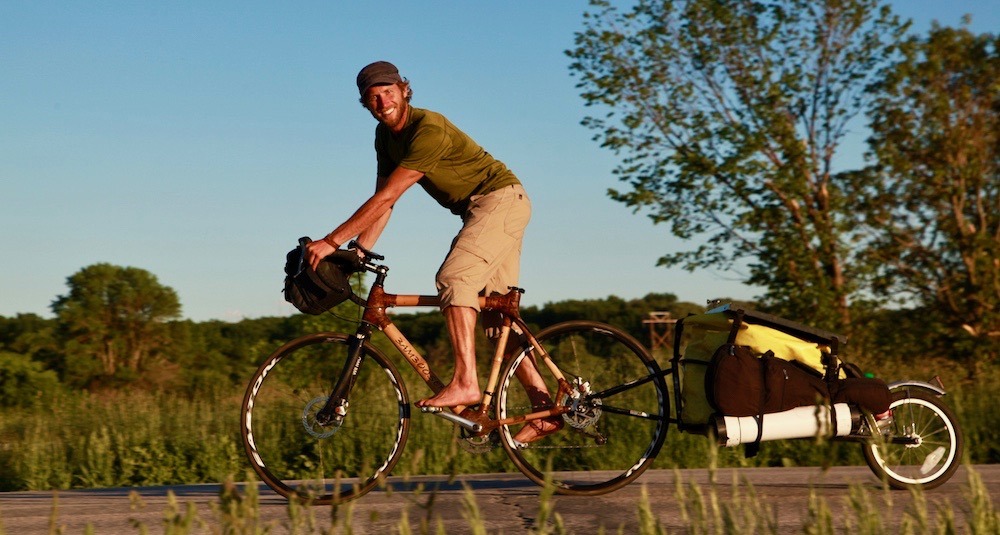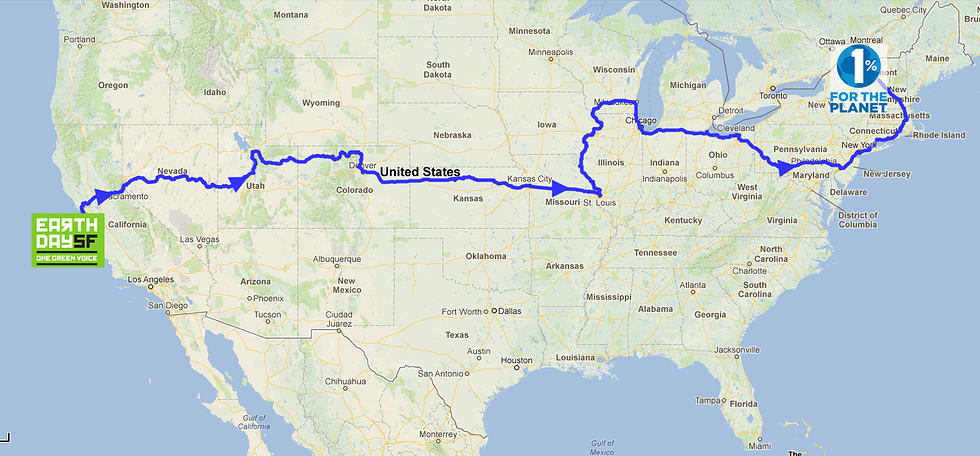Off the Grid Across the USA
Pedaling Coast to Coast for a Sustainable Nation


Cycling 4,700 miles across the USA, that’s the easy part. So what’s the hard part? How about doing it off the grid? That means:
- Using electricity generated by solar panels.
- Creating near-zero trash and carrying it for the entire journey.
- Using water directly from natural sources (lakes, rivers, wells, and rain) or water that is going to waste.
- Eating locally produced, organic, and unpackaged foods or food that is going to waste.
- Using human-generated power and avoiding fossil fuels completely.
- Shopping at businesses that are committed to creating a healthy planet.
Over 104 days of cycling, Robin managed to use just 160 gallons of water, create a mere two pounds of trash, plug into only five outlets, not turn on a single light switch and consume a remarkable 284 pounds of food from dumpsters!
That is 80 times less water, 200 times less trash, 600 times less fossil fuels, and 1,000 times less electricity than the average American!
Off the Grid Rules of the Road:
Transportation
Robin wanted to cross the country without using fossil fuels. That meant not getting into a car, bus, or any other vehicle that uses fuel, even on his rest days in the cities. He managed to do just that. The only time he used fossil fuels was when he had to take a one-mile ferry ride into Manhattan. His share of the fuel was about 0.25 gallons.
Electricity
Robin aimed to create and use his own electricity generated by solar panels. He equipped his bike trailer with Goal Zero solar panels and used the PowerPot to charge electronics from the heat of his campfires. The electricity he generated was used to power his laptop, cell phone, bike lights, and headlamp. He managed not to turn on a single light switch, turn anything on in a house, take a single hot shower, use a stove, or use any electronic device that was not powered by electricity he created.
Electricity that he used indirectly included walking through automatic doors, accidentally triggering automatic lights, buying food when cash registers were used, and getting money at the bank. Wi-Fi was another small electricity draw, but again, his laptop was powered by solar. Even automatic doors and light switches were avoided. He did plug into five outlets during the journey when he ran out of solar energy but wanted to continue to spread the message through social media.
Near Zero waste
Rob planned to create almost no garbage as he crossed the United States. Any waste that was created was recycled, upcycled (re-used), or composted. Anything unable to be re-purposed was carried until he reached Vermont. He weighed and kept track of the garbage that he created.
All food waste was composted, as was most human waste. He created just two pounds of trash in 104 days, while the average American would have created over 150 pounds, averaging 4.5 pounds each day.
Food
Robin’s plan was to eat only locally sourced, organic, natural, and minimally or unpackaged foods. But when he couldn’t find that, which was often, he ate from a dumpster instead. For this trip, local was considered food from within the state he was in or within 250 miles. Food that he purchased mostly came from local farmers’ markets, farms, and eco-conscious grocery stores, but 70% of his diet came from supermarket dumpsters. The idea behind that was to have the smallest environmental impact possible from food consumption. Eating food that would have gone to waste has a positive carbon footprint because it is being diverted from the landfill, and it eliminates the need for virgin resources. When he needed to cook, he made a fire with wood found in the area.
Water
Robin obtained water from natural sources like rivers, lakes, and rain, in addition to wells. He purified it by using the Katadyn Pocket filter. Robin did not turn on a faucet, buy a bottle of water, use a flush toilet, or washing machine, or take a shower. He unexpectedly remained rather clean, presentable and odorless. When water was not available directly from natural sources, he found wasted water in bottles on the side of the road, from leaky fire hydrants and faucets, and from broken sprinklers. He bathed and washed his clothes in lakes and rivers.
Consumption
Robin’s goal was to shop at businesses committed to creating a healthy planet and that practice corporate social responsibility. To decrease the need to purchase items throughout his trip, he stocked up on necessary items before he left. By doing this, food was pretty much his only expense. When he occasionally needed to purchase items, he chose to buy products made in a sustainable way from businesses that practiced sustainable methods. Rather than purchase new items, he also aimed to purchase used items or he re-purposed items he found in the garbage. He did not carry a credit or debit card, so he paid for everything with cash.
Additional Personal Challenges:
Positive Impact
Robin left each state better than it was when he entered it, because he inspired people to live in harmony with the earth, their community, and themselves. He also planted native wildflowers about every other day as he was riding along and hosted some bike riding and seed planting events. See some of the activism campaigns during the adventure here.
Chemical Free
Robin lived 100% alcohol and drug free for the entire summer. Although he typically enjoys beer and wine in moderation, he did not have a drop for the entire summer to promote healthy and clean living.
He avoided all chemicals as well, and did not use any body care products such as shampoo, deodorant, colognes, soaps, and toothpastes that have synthetic chemicals and petroleum-based ingredients in them. He used biodegradable organic soap from Dr. Bronner’s to keep himself squeaky clean.
Positive mindset
Robin wanted his journey to be swear free. Every time he swore, he did 10 push-ups and donated $10 to Below the Surface, a non-profit he works with. He managed to swear just nine times, or about every other state he passed through. He also aimed to have a positive state of mind as much as possible and not complain.
The Off the Grid 1% Initiative
Funds were raised for eight environmental nonprofits that are making Earth a better place to live. The nonprofits are all 1% for the Planet recipients and focus on different aspects of sustainability, including food, water, waste, transportation, and energy. Read more here.
Some Final Statistics from the Adventure
Transportation
4,700 Miles cycled
0.35 Gallons of fuel used
1 Fossil fuel-powered vehicle ridden in
Water
88 gallons of water from off the grid (58 purified from lakes, rivers, springs, and rain, six from wells powered by pump or windmill, 14 from wells powered by electricity
47 gallons diverted from waste (such as leaky faucets, fire hydrants or bottles thrown onto the side of the road)
27 gallons of water from on the grid
161 total gallons of water used
1.55 gallons of water used per day on average
0 Showers taken
0 Washing machines used
Waste
2 Pounds of trash created
9 Pounds of recycling created
Energy
0 Light switches turned on
5 Outlets plugged into
22 Hours plugged into outlets
<1 kW electricity used from on the grid
95% of electricity used was generated by portable solar panels
Food
284 Pounds of food eaten from dumpsters
38 Packaged food items purchased
19 Non-organic food items purchased
36 Non-local food items purchased
263 Ounces of honey
0 Drops of alcohol consumed
And lastly…
9 Curses from Robin’s mouth
To see all of the media from Off the Grid Across the USA click here.
Off the Grid Across the USA now has a book, Dude Making A Difference. 100% of his proceeds are being donated to 1% for the Planet nonprofits. Check out the book trailer here:
And Robin’s Sustainable Living Series is based on this adventure as well: